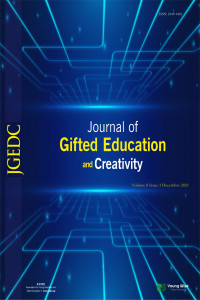Research Article
Year 2021,
Volume: 8 Issue: 3, 89 - 93, 30.12.2021
Abstract
Creativity is an elusive construct that has been examined from different perspectives by different
theorists. Some have postulated that there is a creative personality,
others view it as a process, and still others see it as a conglomeration of different aspects and attributes.
This paper will focus primarily on creativity as it relates to
intelligence and giftedness, but the paper will examine other relevant salient, tangential variables.
Creativity is a construct that has been around for quite some time. It seems to have flourished in the Renaissance, and is often seen in music, art, literature, dance,
theatre and other realms. There have been attempts to assess it via the Torrance Tests of Creative Thinking ( Torrance,1966, 1974 ) and Paul Torrance has devoted his
life to the study of creativity, writing many books about the creative person, process, and personality as well as different cognitive processes. The Torrance tests
attempt to ascertain the amount or degree of elaboration, fluency, flexibility and originality. Trained observers also detect other aspects of one’s responses to the
prompts given on the Torrance Tests. To assess creativity requires a good deal of training- one cannot just pick up the manual and hope to get valid, reliable results on
their first administration. Supervision and feedback is needed. One cannot simply pick up a manual and attempt to procure valid, reliable results.
The Realm of the Intelligence Test- and Intelligence
Intelligence tests have been with us since around 1905 when Binet in Paris attempted to differentiate between those that were thought to benefit from school as
opposed to those who could not seemingly benefit from education. At that time pejorative words such as “moron, idiot and imbecile” was used to describe those who
apparently were of low intelligence- as measured by those primitive measures of the time. Fast forward about 100 years and today we have a wide variety of
intelligence tests, based on different theories- but still attempting to measure, directly or indirectly that elusive concept called “ intelligence”. Some abhor this
concept of intelligence, referring to it instead as “ cognitive processes” or “cognitive ability”.
This paper will also examine the realms of convergent, and particularly divergent thinking as they relate to creativity and also flexible thinking, a construct developed
by Norbert Jausovec (1994 ) of Slovenia. In his text, he explores the realms of flexible thinking, flexible strategies and the enhancement of this type of thinking and its
relevance.
theorists. Some have postulated that there is a creative personality,
others view it as a process, and still others see it as a conglomeration of different aspects and attributes.
This paper will focus primarily on creativity as it relates to
intelligence and giftedness, but the paper will examine other relevant salient, tangential variables.
Creativity is a construct that has been around for quite some time. It seems to have flourished in the Renaissance, and is often seen in music, art, literature, dance,
theatre and other realms. There have been attempts to assess it via the Torrance Tests of Creative Thinking ( Torrance,1966, 1974 ) and Paul Torrance has devoted his
life to the study of creativity, writing many books about the creative person, process, and personality as well as different cognitive processes. The Torrance tests
attempt to ascertain the amount or degree of elaboration, fluency, flexibility and originality. Trained observers also detect other aspects of one’s responses to the
prompts given on the Torrance Tests. To assess creativity requires a good deal of training- one cannot just pick up the manual and hope to get valid, reliable results on
their first administration. Supervision and feedback is needed. One cannot simply pick up a manual and attempt to procure valid, reliable results.
The Realm of the Intelligence Test- and Intelligence
Intelligence tests have been with us since around 1905 when Binet in Paris attempted to differentiate between those that were thought to benefit from school as
opposed to those who could not seemingly benefit from education. At that time pejorative words such as “moron, idiot and imbecile” was used to describe those who
apparently were of low intelligence- as measured by those primitive measures of the time. Fast forward about 100 years and today we have a wide variety of
intelligence tests, based on different theories- but still attempting to measure, directly or indirectly that elusive concept called “ intelligence”. Some abhor this
concept of intelligence, referring to it instead as “ cognitive processes” or “cognitive ability”.
This paper will also examine the realms of convergent, and particularly divergent thinking as they relate to creativity and also flexible thinking, a construct developed
by Norbert Jausovec (1994 ) of Slovenia. In his text, he explores the realms of flexible thinking, flexible strategies and the enhancement of this type of thinking and its
relevance.
Keywords
References
- Sternberg ( 2005 ) but they need updating and revision and new vistas need to be
Year 2021,
Volume: 8 Issue: 3, 89 - 93, 30.12.2021
Abstract
References
- Sternberg ( 2005 ) but they need updating and revision and new vistas need to be
There are 1 citations in total.
Details
| Primary Language | English |
|---|---|
| Subjects | Other Fields of Education |
| Journal Section | Creativity |
| Authors | |
| Publication Date | December 30, 2021 |
| Published in Issue | Year 2021 Volume: 8 Issue: 3 |


